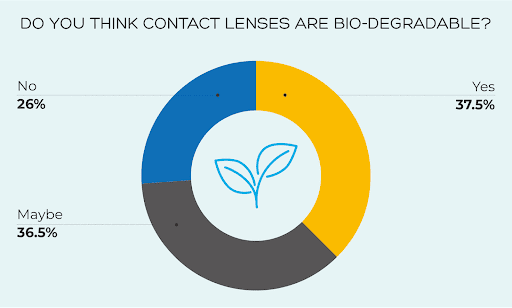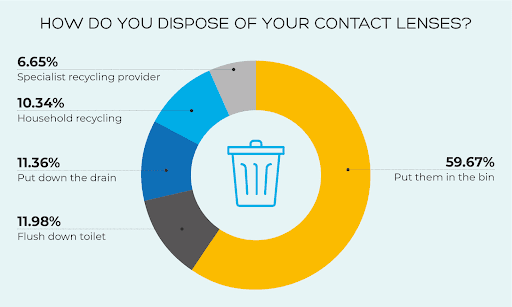It is estimated that between six to ten metric tonnes of plastic lenses end up in wastewater in the U.S. each year. As contact lenses break down into smaller fragments, they pose a huge threat to aquatic environments. As small marine life mistake these for food, these small plastics are introduced into food chains. Eventually, unwanted microplastics find their way into the human food supply, exposing us to unwanted pollutants and contaminants. Incorrect contact lens disposal is a key contributor to this.
Contact lenses are one of many effective options worn by Americans to improve vision. They are a popular choice due to factors such as not having an impact on someone’s appearance and can be considered as a more comfortable option compared to glasses.
To find out more about the effect contact lenses are having on the environment, we asked over 1,100 Americans about their awareness of the environmental impact caused by contact lenses and how people dispose of them after being worn.
Key Findings
- 73.9% aren’t aware that contact lenses aren’t biodegradable
- 59.7% of contact lens wearers dispose of their contact lenses by putting them in the trash with more women (32.5%) compared to men (22.6%)
- 93.3% of contact lens users are not recycling contact lenses which equates to 41.9 million Americans contributing to environmental pollution
- Almost 1 in 4 (23.4%) disposing of contact lenses in the toilet or down the drain
- 54.7% of people who wear contact lenses said they have never been informed on how to correctly dispose of them
Environmental Impacts
Contact lenses are cause for concern as they are made from plastics that are polluting the environment. The Centers for Disease Control (CDC) and Prevention state that an estimated 45 million people in the U.S. wear contact lenses. Those who dispose of their lenses incorrectly can have a huge impact on wildlife and water quality as they fail to decompose and instead break into tiny microplastics, which contaminate ecosystems contributing to an already huge plastic problem.
Research shows that the U.S. produces the most plastic waste per person than any other major country, and its citizens may rank as high as third in the world in contributing to plastic pollution in the oceans.
Over 7 in 10 don’t know contact lenses aren’t biodegradable
When an item is biodegradable, it means that it is capable of being decomposed by bacteria and so avoids polluting the surrounding environment. Unfortunately, contact lenses are one of many man-made items that don’t fit into this category. Research suggests that water treatment plants break down lenses into microplastics which accumulate in sewage sludge.
To understand more about people’s knowledge surrounding environmental impacts involving contact lenses, we asked our respondents whether they thought they were biodegradable.

Overall, 37.5% said they think contact lenses are biodegradable. Just over 1 in 4 (26.0%) of these respondents who think contact lenses are biodegradable, dispose of their contact lenses incorrectly such as flushing them down the toilet or disposing of them down the drain. With 36.5% being undecided on contact lenses being able to biodegrade, it could mean even more people are negatively impacting the environment without having awareness of their actions.
Contact lens disposal
Research suggests that disposing of contact lenses incorrectly is having a huge impact on pollution levels with an estimated 2.5 billion lenses landing into sewage systems each year. To put this into context, this many lenses would wrap around the early nearly 2.5 times. To provide a further comparison, in the entire ocean, there would be 2,212 contact lenses for every turtle or 333 lenses for every plastic straw around U.S. coastlines.
With that, we asked our participants how they dispose of their contact lenses and the outcome wasn’t great.
93.4% are not recycling contact lenses
While many choose to dispose of contact lenses in different ways, only a small group of individuals choose to recycle their lenses properly by using a specialist provider (6.7%.)
1 in 10 respondents also said they recycle their contact lenses using household recycling. While intentions to recycle are a step in the right direction, placing contact lenses in recycling bins isn’t appropriate as they end up being diverted to landfills.
If not disposed of correctly by sending to a recycling provider, contact lenses usually end up in landfills if not our surrounding waters. According to various studies, estimates state that the plastics used in contact lenses can take anywhere from 100-500 years to decompose, even after this, they would become microplastics in the environment.

Our results show that over half (59.7%) said they dispose of contact lenses by simply putting them in the trash. Females were the worst offenders with nearly 32.5% of users disposing of contact lenses in this way compared to men (22.6%.)
1 in 8 (12%) said they flush their contact lenses down the toilet along with others who put them down the drain (11.4%.)
In total, 93.4% of respondents declared that they are not recycling their contact lenses. Using the CDC estimation of total contact lens wearers in the U.S, that would mean 41.9 million Americans are not recycling their lenses at all.
Almost 1 in 4 (23.4%) are putting microplastics in the water supply by putting contact lenses in drains or toilets
With almost 1 in 4 (23.4%) either putting contact lenses in the toilet or down the drain, there is also the significant risk of lenses breaking down and causing a host of environmental and health problems. Arizona State University analyzed this issue highlighting the damage that contact lenses in our water can cause:
Over half (54.7%) not informed on how to dispose of contact lenses correctly
- Run-off from sludge-amended soils polluting surface waters
- Microplastics accumulate in sewage sludge which is routinely applied onto land for disposal and soil conditioning. This provides microplastics with another route to invade more ecosystems
- Aquatic organisms mistaking plastics for food resulting in toxic chemicals being introduced to food chains
If the way the majority of people dispose of their contact lenses wasn’t already an issue, it turns out that most haven’t actually been informed on how to do so correctly.

Over 5 in 10 (54.7%) people who wear contact lenses said they have never been informed on how to dispose of contact lenses in the correct way. Contact lens manufacturers currently place inserts inside their packaging with recycling and care information for users.
Methodology
The survey was conducted via Amazon’s Mechanical Turk platform collecting responses from 1,167 Americans from a range of backgrounds in October 2021. The demographic breakdown of our respondents is as follows:
Gender:
- Female (54.76%)
- Male (44.73%)
- Other (0.51%)
Age:
- 18-24 (9.17%)
- 25-35 (37.70%)
- 35-44 (30.16%)
- 45-54 (12.25%)
- 55-65 (8.48%)
- 65+ (2.23%)
References
-
The environmental cost of contact lenses (August 2019) American Chemical Society
-
Don’t throw those contact lenses down the drain (August 2018) Arizona State University
-
Types of contact lenses (January 2018) U.S. Food and Drug Administration
-
US and UK citizens are world’s biggest sources of plastic waste – study (October 2020) The Guardian
-
Contact lenses are a surprising source of pollution (August 2018) Scientific American
-
How big is earth? (July 2021) Space.com
-
How many sea turtles are left in our oceans? (August 2018) Xplore Our Planet
-
Science says: amount of straws, plastic pollution is huge (April 2018) Science X
-
Don’t flush contact lenses. Recycle them (November 2021) All About Vision
Last Updated March 1, 2022
Note: This page should not serve as a substitute for professional medical advice from a doctor or specialist. Please review our about page for more information.